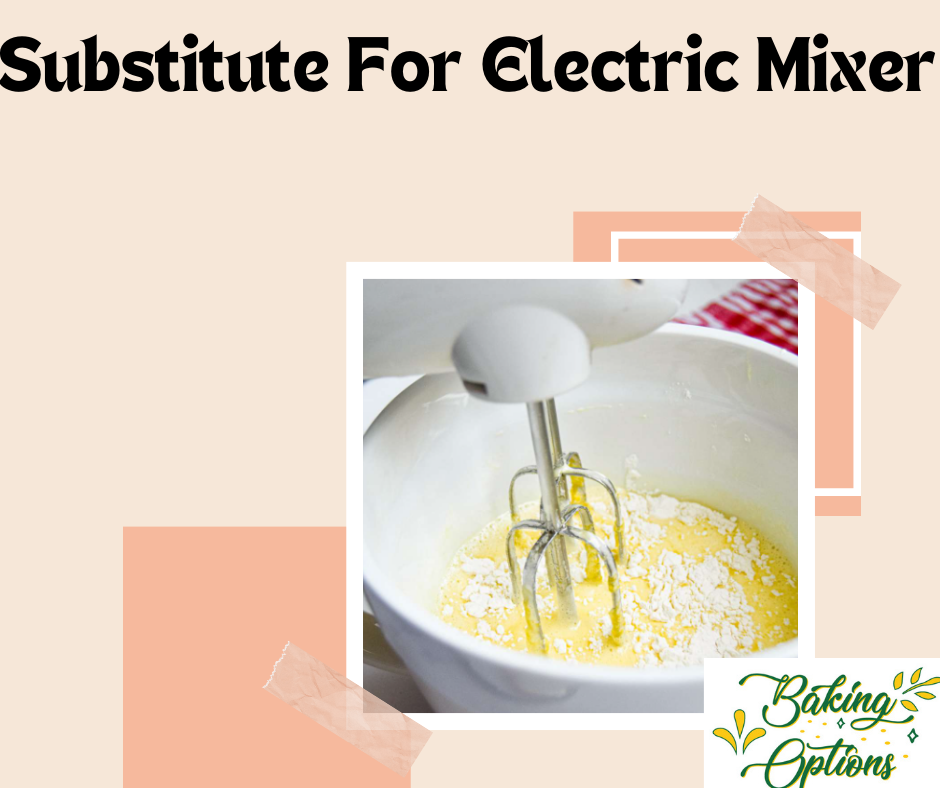As the name implies, electric mixers allow all levels of home bakers to automate the process of whisking and beating dry ingredients.
Most bakers already know, I’m sure, that electric mixers fall into two categories when it comes to kitchen appliances: hand mixers and stand mixers. The more potent, entirely hands-free option is the former of them.
I’ll give you a hand by explaining in my comprehensive guidelines how to beat without a mixer using other kitchen tools.
Contents
Best Substitutes for Electric Mixers
Either a manual or an electric substitute will ultimately determine which electric hand mixer options you choose. My selections for your top choices in each category are as follows.
Hand Mixers

Hand mixers work well for whipping, frosting, and even icing. They are a great option for airy yet smooth cake batters and stiff peaks because their air volume is nearly identical to that of electric mixers. Not to add, the surface textures are uniformly distributed!
There is, nevertheless, a significant disadvantage. Compared to certain higher-end stand mixers, hand mixers are significantly smaller. You should prepare yourself since kneading dough could become quite the task!
Whipping is quick and simple. comparable outcomes to those of electric heavy-duty mixers. But, this kitchen appliance’s splatter shields could cause tragedies. Also, unable to knead bread doughs or combine dry cake components.
A Whisk

A handheld whisk is one of the greatest hand mixer substitutes available. It will be useful for beating eggs, combining light batters, or incorporating air into any other recipe that calls for it.
If you can persevere long enough, you should discover that a whisk works well at fully mixing your ingredients. If you’re dreaming of those flawless meringue peaks, get ready to work up a sweat and be swept away for a time.
A whisk works well for lighter cakes like Chiffon or Genoise sponge, but it will definitely struggle with heavier batters like cookie dough because the thicker batter will clog the whisk.
Food Processor

Food processors are commonly used for chopping, slicing, and dicing food, but they can also be used as mixers. A lot of food processors have whipping and mixing attachments. Additionally, food processors may puree the components, which in some cases might be more useful than using a regular mixer.
The mixer attachment that most food processors have may look like a hand whisk. This item allows you to convert the food processor into a mixer by replacing the blades. The blades can be used to mix some substances if you don’t have a mixer attachment. Although this isn’t ideal if you don’t want to chop or puree.
When it comes to mashing potatoes, squash, and other mixes, electric mixers are also quite helpful. To achieve a texture comparable to mashing, you can purée the ingredients in a food processor if your mixer isn’t working.
Using a food processor has only one disadvantage: the work bowls are smaller, so you’ll need to add the mixture multiple times to finish it. But because it’s electric-powered, you can combine much more quickly than with a hand mixer for combining heavy batter or kneading dough.
Your Own Hands

Experienced cooks like myself still love using manual kneading techniques. After all, I seldom ever need to buy anything—all I really need are my own fingers and a little additional care or work! Furthermore, kneading dough hooks for the whole afternoon with my kids strengthens our relationship.
The whole idea of kneading dough is to stretch it evenly and consistently without breaking it; the secret is to work gently and continuously. Give them additional time to respond to your light pressing and exercise patience. A flawless dough should appear in as little as 10 to 15 minutes, depending on the amount, if done correctly.
Making dough by hand has its advantages and disadvantages. On the positive side, it is very easy, especially for beginners, and requires no tools at all, making it a cost-free method.
However, the process does require significant manual energy and effort, which can be energy-draining and exhausting. Additionally, it is time-consuming, and some people may struggle with smoothing out the textured dough and removing clumps.
Blender

If you are in a pinch, your immersion blender and stand blender can both be useful for baking. Although it does a good job of combining all the wet components. The batter may not turn out as you had hoped due to its lack of air whipping.
If using a blender, blend in the sugar, melted butter, and eggs until the mixture is light in color. Place the liquid mixture into a bowl and begin incorporating the dry ingredients. Even though blenders are rather strong, there is a chance that you could overmix the batter if you try to mix the entire batch in one.
Overmixing will result in an excessive amount of gluten developing in the flour and an unappealing cake texture. Using a blender is a quick and simple solution, but be aware that the texture of your cake will be compromised. It works well as a baked cheesecake batter as well.
Spatula

Spatulas are perfect for combining fine batter, cake components, and other baking ingredients since they are more flexible than mixing spoons. Spatulas are multipurpose instruments that can be used to flip tortillas and pancakes as well as spread butter, margarine, or honey in place of a mixer.
While wooden or metal spatulas are available, silicone ones work best for mixing. Though a wooden mixing spoon would be a preferable option in situations like these. These spatulas are ineffective when mixing thick batter or dough.
Fork

A standard fork will work just fine if you don’t have an electric mixer and don’t have time to get a mixing spoon or spatula. Many cooks use forks instead of mixers, and it’s incredible how much fine texture can be achieved with just a fork. You can mix practically anything with a fork, including salad dressings, batters, and even drinks.
In addition, it is readily available, doesn’t require electricity. If you’re not combining a lot of materials, can be fairly effective. The small size of a fork makes it unsuitable for mixing components in larger containers, which is the only drawback of using it as a mixer.
Bottom Lines
I’ve covered seven upscale alternatives to electric mixers and blenders in my list. Yes, they have certain noticeable issues, but they can still process a lot of ingredients if they are used carefully and expertly!
Relevant Post: How to Sharpen a Serrated Knife

